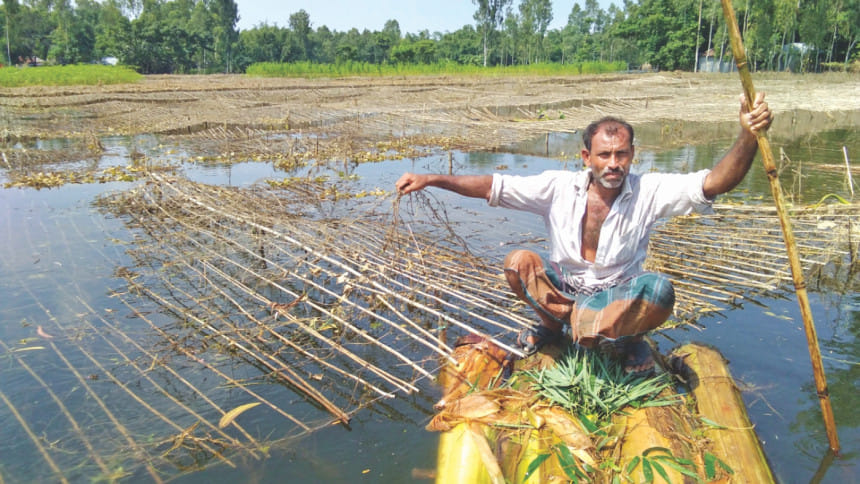Floods wreak havoc on croplands

The ongoing flood has submerged 60,000 hectares of paddy and vegetable fields, mainly in the northern districts, affecting both farmers and consumers, as crop loss has sent the vegetable prices soaring for reduced supply in the market.
The Department of Agricultural Extension (DAE) estimated that floods affected farmlands in 26 districts until Friday, including 39,000 hectares of aush fields, 11,000 hectares of aman seedbeds, and 10,000 hectares of vegetable farms.
The flooded aush fields constitute 3.39 percent of the total acreage of aush this year.
A senior official of Bangladesh Rice Research Institute (BRRI) said 20 percent of the submerged aush crop might get damaged fully. This would mean the loss of 20,000 tonnes of paddy if the average aush output of last year is considered.
“The plants that are in the tillering stage is unlikely to be damaged, but those in the flowering stage will be lost,” the official said.
Matiur Rahman, a farmer of Ghogadaha union in Kurigram, which is one of the worst-hit districts, said, “All of my aush paddy has been ruined by water.”
Having only three bighas of farmland, he has to rent land and farm it to make a living.
Matiur planted paddy on five bighas during this aush season with the hope to augment his income after suffering for the low prices of boro, harvested in May-June.
The flood has started receding from his locality but Matiur said nothing would be left. “I was planning to harvest aush in three weeks’ time.”
His peril does not end here. “All the aman seedlings and standing vegetables were damaged,” he said. “The same befell other farmers in my locality. Many of them lost their stored paddy, too.”
Cultivation of aman, the second biggest rice crop after boro, faces setback with 11,000 hectares of its seedbeds having been inundated, said Md Abdul Muyeed, director of field services wing of DAE.
Floods came as a successive shock after growers were trying to recover from low boro prices this year, caused by a good harvest and higher public and private stocks.
“Nothing we had in the field will remain after the flood,” said Matiur, who grew vegetables on four decimals of land to meet his family needs.
“This is the worst-ever flood after 1988. There is water everywhere. We are suffering badly.” Matiur has taken shelter on an embankment near his residence.
According to DAE, the flood submerged summer vegetables on 10,000 hectares of land until Friday, and none of them may survive after the flood.
A trip to village two unions of Kurigram sadar revealed that all the farmland was flooded, with no crops standing above the water level. Only the remains of dead vegetable plants were visible.
DAE official Muyeed said all aman seedlings might get destroyed, but there is time to prepare seedbeds newly for aman plantation. “Farmers may have the seeds.”
The official said a portion of aush paddy could be saved if water recedes within one or two days. “We will be able to calculate the total financial loss after the flood.”
DAE estimates that farmers have planted aush on 11.49 lakh hectares, while it aimed to bring 58.79 lakh hectares under aman cultivation this season.
Aman is harvested in winter.
Farmers have planted summer vegetables on 3.32 lakh hectares this year.
Chhakmal Hossain, a farmer in Pachgachhi Union of Kurigram upazila, who grew painted gourd on two bighas, said all his crop is gone.
The same happened to his neighbour Moazzen Hossain. “I was hoping to make a good a good profit from the harvest,” he said.
CONSUMERS PAYING HIGHER
With farmers and people of affected areas suffering, residents in urban areas, particularly Dhaka, are seeing a sharp rise in the prices of greens.
Green chilli sold at Tk 80 a week ago per kilogram, but the price soared to as high as Tk 200 in the capital, said Imon Mia, a vegetable retailer at Sankar in Dhanmondi area.
Prices of other vegetables including brinjal, okra, wax gourd, and bitter gourd rose by Tk 10-15 per kilogram, he said. “This is because of flood.”
Delwar Hossain Kusum, joint secretary of wholesalers association Karwan Bazar Aratdar Samity, echoed Imon.
According to the Department of Agricultural Marketing, the average prices of green chili soared by 54 percent to Tk 140 per kg in Dhaka on Thursday from a week ago.
Prices of eggplant, pointed gourd, okra and snake gourd also shot up by 13 to 32 percent during the same period, it says.
DAE Director Muyeed said flood situation has improved in some areas such as Lalmonirhat and Nilphamari, but new areas are getting affected.
To support farmers, DAE has taken an initiative to prepare aman seedbeds on government-owned land for plantation after the flood, he said.
“We are also planning to make 2,500 floating seedbeds in flood-hit areas,” he said, adding that seeds of a variety of pulses would be provided to growers.

 For all latest news, follow The Daily Star's Google News channel.
For all latest news, follow The Daily Star's Google News channel. 



Comments